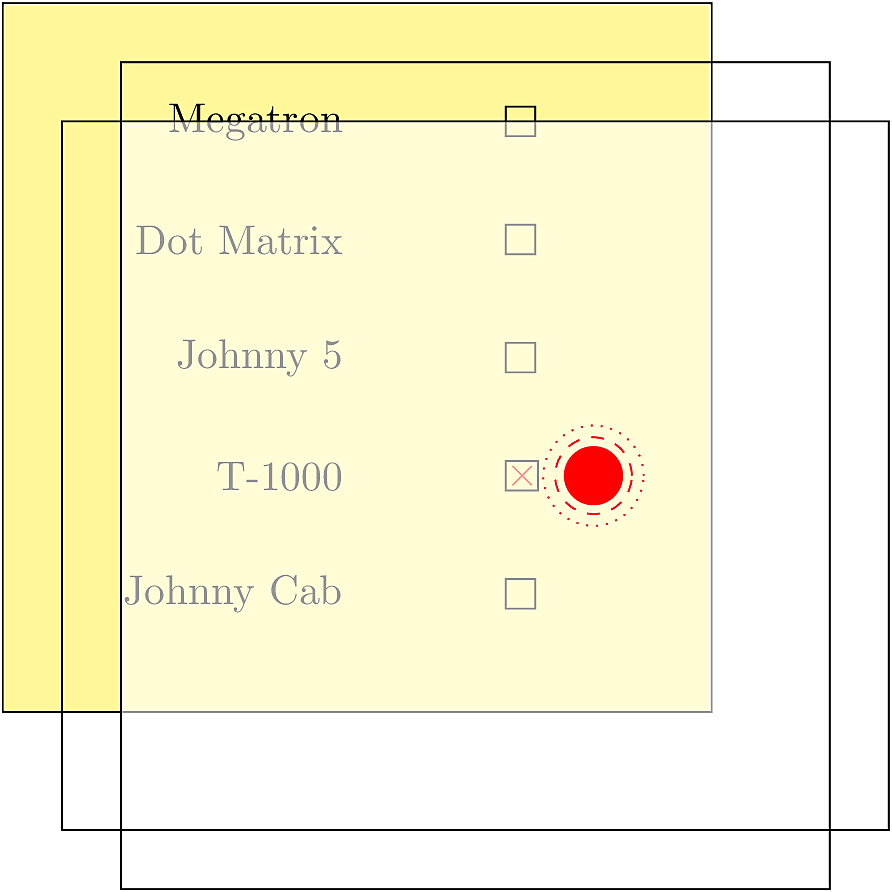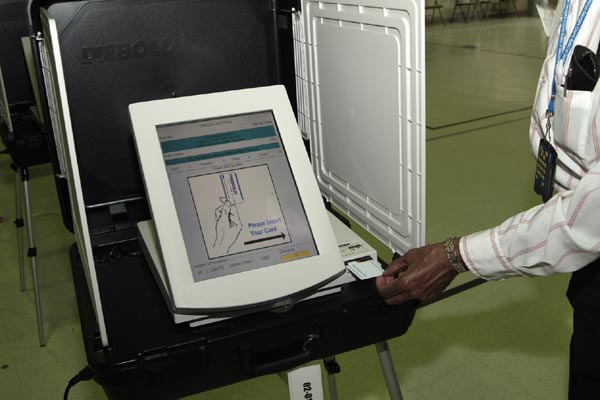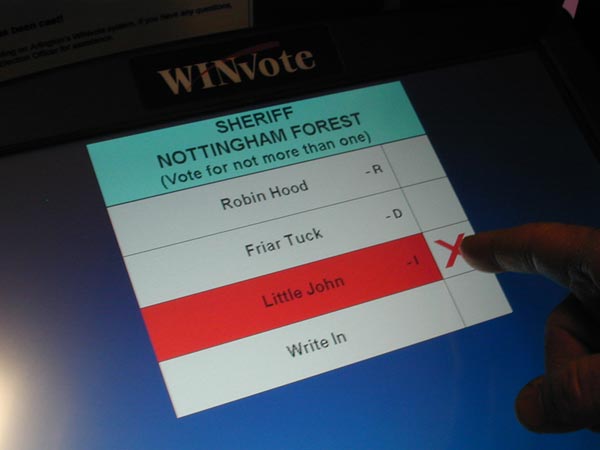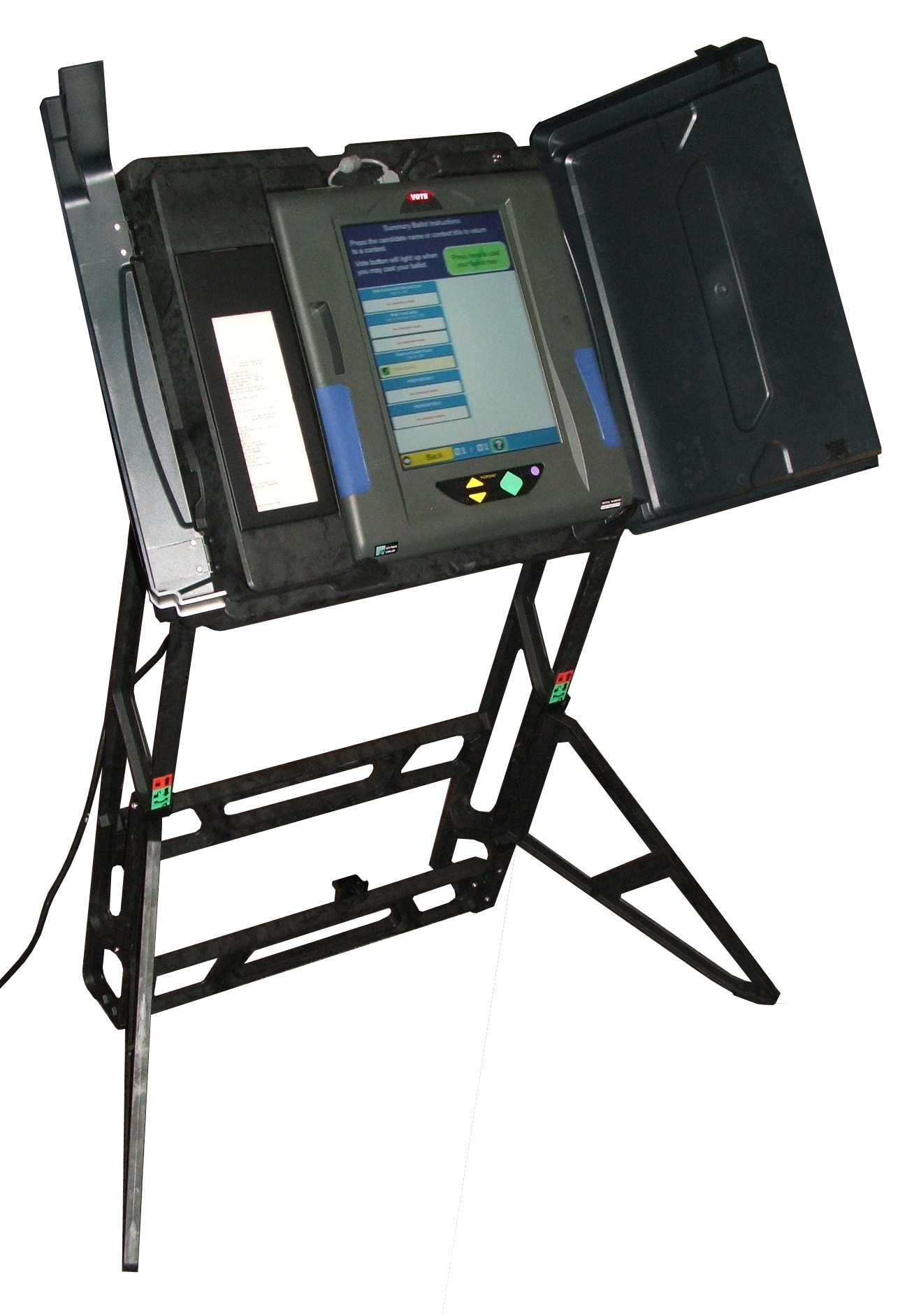Digital Democracy
Topics
Electronic Reliability
Voting and Finance Technologies
Fault Tolerance and Error Detection Techniques
Novelty Bias: Does Newer Always Mean Better?
Reliability of Critical Technology
Hanging Chads: Gore vs Bush, 2000
- The 2000 US Presidential election was decided by four counties in Florida.
- Machine counts showed a margin of just over 300 votes favoring Bush.
- Gore supporters claimed ballots were undercounted in Gore-favoring areas due to the Votomatic key-punch technology used in those areas.
- Ballots were rejected for Incomplete key-punches, called hanging chads.

- Gore supporters argued a manual recount could discern the intended votes and change the outcome.
- Florida Supreme Court ordered a manual recount.
- US Supreme Court halted the recount.
Belgian Federal Election, 2003
Belgium votes are by party.
- A voter can vote for one party,
- or can choose preferred candidates from a list within the same party.
- All votes for party’s list decide whether the party wins.
In 2003, one individual candidate got more votes than the party list, implying a machine error.
Possible explanations:
- Fraud (poorly executed)
- Software mistake
- Electronic fault
An audit found no evidence of fraud or programming mistakes, so…
Electronic Faults
The Belgian error was most likely caused by an electronic fault – called a soft error or single event upset (SEU) – deep in the system’s circuitry.
Computers are built from tiny semiconductor devices. They are particularly sensitive to
- Radiation (α particles from trace heavy metal contaminants)
- Cosmic Rays (high-energy particles that rain down from outer space)
These phenomena constantly create momentary errors in computers. Usually the errors have little consequence and we don’t notice them.
Scientists concluded that a cosmic ray most likely caused the Belgian error.
American Voting Machines
Direct Recording Electronic (DRE) Voting Machines
DRE machines typically use:
- Touch screens to display and indicate votes.
- Internal memory to store votes.
- Paper receipts (kept on a roll in the machine) for verification and recounts.
DRE Problems
A DRE is a computer, so it can have electronic errors like single-event upsets.
Problems specific to DREs:
- Touch-screen miscalibration (finger is detected in the wrong place).
- Paper errors (mechanical failure, paper runs out, etc).
- Programming errors are not uncommon.
- Privatized design and manufacturing inspire speculative conspiracy theories.
- Hacking. Several security flaws have been demonstrated.
How Touchscreens Work
For heavily used public interfaces, a resistive touch screen is typically used.
It has two transparent sheets separated by a small gap.
A voltage gradient is applied to the top sheet.
A voltage meter is connected to the back sheet.
When the screen is pressed, the sheets touch. The voltage from the top sheet is measured twice at the back sheet to get the horizontal and vertical position.
Measuring the X (horizontal) position:

Measuring the Y (vertical) position:

Touchscreen Problems
Alignment: the touch sensor is attached over a screen, but they are separate devices. Software calibration is supposed to compensate for the geometry offset between the layers.
Good calibration

Bad calibration

The electrical offset can also drift over time due to:
- Material Damage can alter the voltage pattern on the top layer.
- Electronic Damage caused by power surges or static electricity.
- Physical Aging can change the layer characteristics over time.
- Environment like temperature and humidity can have an effect.
Some changes can be fixed by periodic re-calibration.
Diebold Conspiracy Theory, 2004
In the Presidential election of 2004, polling data suggested that John Kerry would likely win, yet George W. Bush was elected by a sizeable margin, more than 3 million votes.
Some activists claimed there were irregularities in DRE voting:
- Conflicts of interest:
- CEO of Diebold was a Bush fundraiser.
- Senator Chuck Hagel (a Bush ally) was former chairman of DRE maker ES&S.
- Data anomalies:
- Poll analysis appeared to show “excess” Bush votes in counties that used DRE machines.
- (The discrepancy can be attributed to the polling data, not the vote tally).
- No paper trail:
- HAVA requires paper receipts, but the regulation was not yet implemented in 2004.
- Felon Programmers:
- A former executive tied to Diebold was convicted of altering records in a computerized accounting system, in an unrelated case.
Princeton DRE Hacking Study, 2006
From the study abstract (emphasis added):
an attacker who gets physical access to a machine or its removable memory card for as little as one minute could install malicious code; malicious code on a machine could steal votes undetectably, modifying all records, logs, and counters to be consistent with the fraudulent vote count it creates. An attacker could also create malicious code that spreads automatically and silently from machine to machine during normal election activities — a voting-machine virus. We have constructed working demonstrations of these attacks in our lab.
While there was no specific evidence that malicious hacking occurred in 2004, these findings further undermined trust in DRE machines and fueled conspiracy speculation into the next election.
Software Errors
Even updated DRE machines have major bug reports.
In a 2019 judge’s race in Northampton PA:
ES&S machines tallied just 164 votes for the favored candidate.
After a hand count, the vote increased to 26,142, winning the election.
How is this possible?
Human Error
An estimated 30 percent of the Election Systems & Software ExpressVote XL machines were improperly calibrated by the company, leading to “hypersensitivity” problems in registering some voter choices. In addition, problems with the ballot layout – also blamed on the manufacturer – led to problems electronically tabulating votes the night of the election, Nov. 5.
“I want to make clear that this was human error, and ES&S takes full accountability,” Adam Carbullido, ES&S senior vice president of product development, said during a news conference alongside county Executive Lamont McClure at the county courthouse in Easton.
He apologized to the county administration, which recommended to county council the purchase of 320 of the new machines earlier this year to comply with a state mandate to begin creating a paper-ballot trail of votes. The $2.88 million contract includes hardware, software, maintenance and support and firmware licensing.
Optical Scan Voting Machines
Optical scan ballots are widely used in vote-by-mail systems.
Prior to the 2020 election, Utah instituted universal vote-by-mail.
Benefits of Optical Scan Technology:
- Reduces exposure to hacking.
- Easy to audit and verify by re-count or hand-count.
- Equipment is specialized, fewer types of failure.
Drawbacks:
- Electronic errors: Scanners sometimes mis-read ballots.
- Human errors: Election workers operate counting equipment incorrectly.
- Voter failure: Voters mark ballots improperly.
- Opaque Process: Voters cannot confirm their votes are correctly counted.
In spite of the drawbacks, mail voting is probably the most secure and reliable approach available.
Optical Scan Errors
- Accidental marks or creases.
- Printing errors, unreadable bar codes or QR codes.
- Some inks not detectable by imaging scanner.
- Votes indicated with check-marks, circles, stars, etc.
- Ballots mis-aligned in feed mechanism.
- Ballots fed upside down.
- Humidity effects (e.g. paper jams, ink smears).
- Programming errors still occur.
Surge of Conspiracy Theories
Conspiracies, 2000-Present
Since 2000, election challenges have become routine.
The dubious field of “election forensics” emerged.
Conspiracy theories reached an apex in 2020 (we hope).
Voting machine errors have always been present, but now…
- More voters are motivated to look for them,
- Phones make it easy to document them,
- Social media makes it easy to broadcast them.
So many bug reports would be great, except that people see them as evidence of coordinated wrongdoing.
Conspiracy theories have targeted every type of voting process.
- Self-styled “forensics experts” circulate lengthy documents with inflammatory accusations.
- Some political groups are exploiting the moment.
- Recent accusations about Dominion voting machines resemble the 2004 Diebold conspiracy theory, only the parties are switched.
This blog post promotes the Dominion conspiracy theory (it has nothing to do with Utah):

Why are Conspiracy Theories Unlikely?
A classic problem in game theory called The Prisoner’s Dilemma:
- A group of prisoners are jailed separately.
- Physical evidence against them is insufficient.
- If no one speaks, they all go free,
- OR The first one who confesses can go free, but all the others will be convicted.
Usually someone confesses, gets a personal reward at the expense of all the others.
For an example, see the January 6 Hearings where much of Trump’s own administration testified against him.
Conspiracies do occur, but they are unlikely to stay secret.
Telecommunications and Polling Failures
Election conspiracies creeped out of the fringes after 2000, partly because of surprise election results.
Back in 1996…
- Telephones connected via land lines to physical addresses – you could contact a place and speak to the people there.
- Phone numbers were generally published in a phone book.
- A polling company could call people in a specific district and ask their opinions.
- I worked processing poll data for Republican Bob Dole, and we knew with high confidence that he wasn’t going to win. When he lost, it was unsurprising.
In 2000, cell phones had become commonplace. By 2004, land lines were vanishing. By 2008, smart phones were on the market.
- Accurate polling became impossible.
- It’s interesting the digital technology is a root cause of this problem too.
When election results deviate from poll predictions, people are surprised, and they spin conspiracy theories.
Comparison to the Finance Industry
Voting and Financial Transactions
Highly Reliable Hardware
- Many large financial institutions use specialized mainframe computers specifically designed to correct and recover from faults.
- An important example is the Tandem Computer, which originated in 1974. From Wikipedia:
Tandem Computers, Inc. was the dominant manufacturer of fault-tolerant computer systems for ATM networks, banks, stock exchanges, telephone switching centers, and other similar commercial transaction processing applications requiring maximum uptime and zero data loss….
…Tandem’s NonStop systems use a number of independent identical processors and redundant storage devices and controllers to provide automatic high-speed “failover” in the case of a hardware or software failure. To contain the scope of failures and of corrupted data, these multi-computer systems have no shared central components, not even main memory.
- The Tandem computer systems evolved into the modern HPE NonStop server products.
What is “Fault Tolerance”?
The NonStop system advertises “100% Fault Tolerance”.
There are many approaches to fault tolerant design. Here are some (that may or may not be in the NonStop system):
- Triple Modular Redundancy
- Make three copies of every processor, data item, and computing operation. At each step, take a majority vote to decide the result.
- If one module fails, the other two compensate for it.
- Used in aerospace, medical and other safety-critical systems.
- Checksum
- A checksum is a number that summarizes some numerical data.
- If the data is altered, the checksum will fail to match.
- Can be used for both reliability and security.
- Error Correcting Codes (ECC)
- ECC is a more sophisticated version of the checksum method.
- With ECC, you can detect errors and also fix them.
Checksum Example
Suppose we want to protect a number with several digits, like 37269.
As a checksum function, we can repeatedly add together the digits like so, always adding digits until we reduce the sum to a single digit:
3 + 7 2 + 6 + 9
= 10 + 8 + 9
= 18 + 9
= 1 + 8 + 9
= 9 + 9
= 18
= 1 + 8
--------------------------
= 9
Now append the result to our number, so it becomes 37269,9.
Now if any single digit is altered, a recalculation of the checksum will not match up.
ECC Example
The easiest way to visualize an error correcting code is with the English language.
Say we have a word, like “neighbor”.
I change one letter: “nejhbor”.
We can tell which letter is wrong. This is because the word “neighbor” has more letters than it needs. The extra letters are redundant, they allow us to detect and correct spelling errors. We could spell it “nbr”, but then a single error would make it unreadable.
In essence, ECC uses “spelling rules” for numerical data so that faults can be corrected.
Specialized Programming Language: COBOL
The Downside to Specialized Systems
- The banking industry has been unable to move away from COBOL.
- Computing education has forgotten about COBOL.
- The majority of COBOL programmers are over 50.
The Big Picture
Comparing voting systems with financial systems, we see two trajectories:
- Voting systems:
- Novelty bias: new tech must be better (it wasn’t).
- Low-cost standard computing platforms.
- Reliability was an afterthought, led to social destabilization.
- Financial systems:
- Specialized Engineering, on its own course since the 50’s.
- Fault Free (almost), mission-driven rather than cost-driven.
- Facing a sustainability crisis due to extinction of experts.
There is no right answer or best practice, there are hard tradeoffs and value judgements in every part of this problem.
Electronic systems fail all the time. They are not politically motivated. We should not blindly trust our computers, but we should try and give the benefit of the doubt to our human neighbors, institutions, election officials and volunteers.


.](figures/belgium_ballot.jpeg)





















Social Media and “Information Bubbles”
Today, people arrange their informational lives around their prior beliefs.
It can seem that their personal opinions represent the majority.
When reality doesn’t match, it can be hard to process.
A Utah County candidate speculated about fraud in last month’s primary: